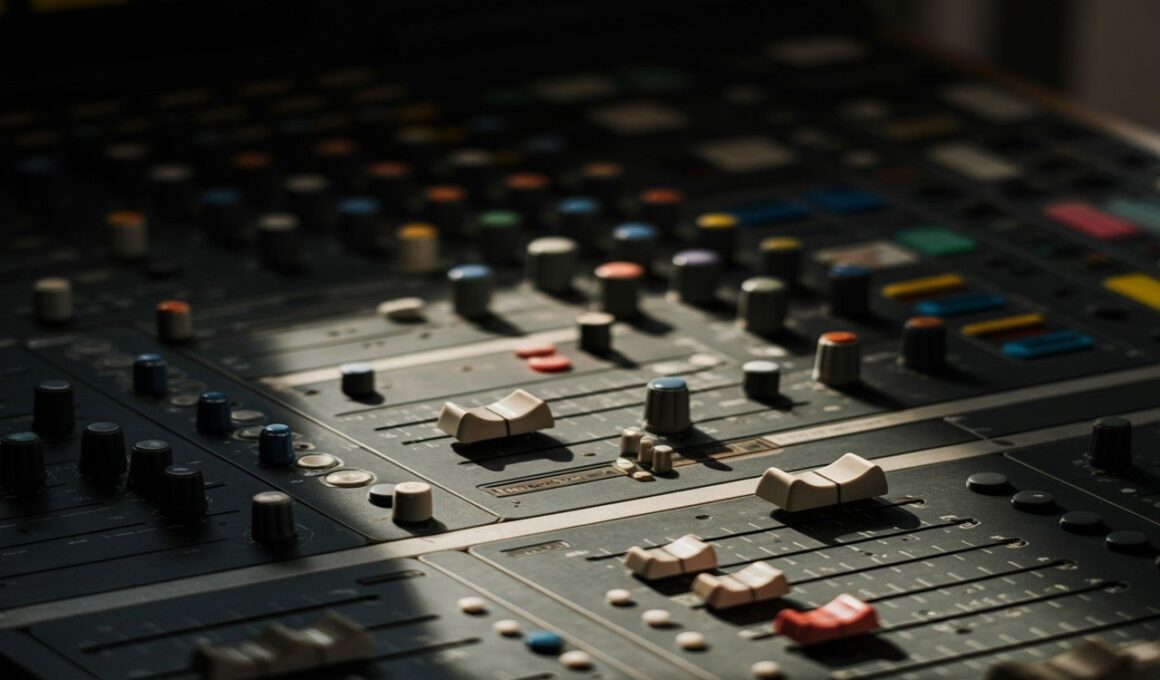Tips for Mixing Audio Like a Pro in Streaming Software
Mixing audio effectively is crucial in streaming, as it enhances audience engagement. To start, familiarize yourself with your streaming software’s audio settings. Key programs include OBS Studio, Streamlabs, and XSplit. Learn how to access the audio mixer and utilize its features to balance your sound levels correctly. Ensure microphones and music tracks are set to appropriate levels. It’s essential to avoid audio clipping, which can detract from a professional audio experience. Balance can make or break your stream’s audio quality. Monitor your audio levels constantly while streaming. Use sound monitoring tools to ensure your voice is not overshadowed by background music or other sounds. In addition, practice adjusting audio levels on-the-fly to react to unexpected situations. Lastly, engage with your audience regarding audio preferences. Asking for feedback about audio clarity and background noise can lead to significant improvements in your setup. Check your hardware as well—microphone quality impacts sound clarity significantly. Investing in a decent microphone can help ensure professional audio output, making your streams more enjoyable for everyone.
Next, exploring audio effects can elevate your streaming experience. Utilizing equalization, compression, and reverb can change how audio sounds dramatically. Each of these effects serves a unique purpose. Equalization allows you to adjust different frequencies, enhancing clarity and presence. Compression helps maintain a consistent audio level, preventing overpowering peaks. On the other hand, reverb can create depth, making the audio feel more immersive. Experiment with these effects within your streaming software to enhance your audio production quality. Don’t overdo it; subtlety is key in audio mixing. Too many effects can muddy the clarity of your stream. Also, consider using presets available within your software—as they can simplify the process significantly. Many software options have built-in presets that are tailored for specific audio scenarios, including gaming and music streaming. Don’t hesitate to tweak these presets to suit your personal style! Additionally, mastering the routing of your audio sources can provide further control over your mix. By properly routing inputs and outputs, you can enable or disable audio sources independently, which allows greater flexibility during live streams.
Another essential aspect is maintaining a clean audio environment. Background noise can be distracting and lead to unprofessional-sounding broadcasts. To minimize unwanted noise, isolate your recording area as much as possible. Use acoustic panels, carpets, or curtains to absorb sound. Ensure that electronic devices causing interference are turned off or moved away. This method directly impacts the overall audio clarity during streaming sessions. Using noise gates is another effective tool. A noise gate automatically shuts off the audio signal when it falls below a certain threshold. Programs like OBS and Streamlabs offer built-in noise gate settings, which can be adjusted to suit your environment. Play around with different threshold levels to find the right balance for your setup. Additionally, perform sound checks consistently to make adjustments in real-time to your streaming audio mix. Encourage friends or followers to provide feedback on audio quality as well. Continuous adjustments can lead to a more polished sound overall, enhancing the viewer experience. Remember, clear audio is fundamental in keeping your audience engaged throughout your live stream.
Incorporating Music in Your Streams
Incorporating music seamlessly into your streams can create an engaging atmosphere. Choose tracks that align with your streaming content, as they enrich the overall experience. Whether you use royalty-free music or licensed tracks, the selection process is vital. Platforms like Epidemic Sound or Artlist provide licenses for use during live streams, which can save you from copyright issues. You can also utilize various online communities dedicated to sharing music for streamers, which often include tracks designed specifically for this purpose. Besides the music choice, managing audio levels is essential. Ensure background music complements your speech without overpowering it. Using the audio mixer in your streaming software, maintain clear communication even with music playing softly in the background. A great tactic is to set music levels lower initially and gradually increase them, gauging audience reactions. Moreover, consider the genres of music that resonate with your audience. Different streaming categories—like gaming or cooking—demand different musical vibes. Take time to engage with your audience about their preferences for music during your streams.
Using sound effects can also add an interactive layer and enhance entertainment value. Sound effects can mark significant moments during your stream or act as a reaction tool. These include applause, cheers, or sound cues that indicate events in your broadcast. When utilized correctly, audio effects can effectively re-engage viewers, making them feel a part of your experience. Different software provides ways to implement these sound cues easily; explore options and familiarize yourself with them. Using hotkeys allows you to play these audio clips seamlessly during your streams, ensuring no interruptions in your flow. Moreover, be conscious of the length and volume of sound effects. Keeping sound effects brief prevents them from overshadowing ongoing discussions or action. Exploring available sound libraries might spark creative ideas for incorporating sounds that fit your theme or branding. Ultimately, developing a unique audio identity can help your streams stand out. The combination of music, mixed audio, and sound effects leads to richer content—an essential aspect of successful streaming.
Testing and Feedback
Testing your audio set up before going live is vital for achieving optimal conditions. Before each stream, incorporate audio tests in your routine. This will allow you to confirm all sources are functioning correctly and at desired audio levels. Moreover, consider using recording software to capture your voice during tests. Listening back enables you to identify issues you might miss while streaming live. Gathering feedback is another integral step in mastering audio mixing. Engage your audience by encouraging them to provide their input on the audio quality. Constructive criticism can facilitate meaningful improvements, making your streams sound better. Reach out through polls, social media, or chat, inviting followers to provide their thoughts on audio clarity, volume balance, and music integration. Implementing changes based on this feedback shows your audience you care and are willing to improve. Building a rapport based on open feedback can ultimately enhance your community experience. Regularly review your audio performance in previous streams to identify common trends in feedback to address their needs effectively.
Lastly, maintaining consistency in your audio settings ensures a signature sound across all broadcasts. Using similar equipment and settings becomes essential to avoid fluctuations in sound quality or character. Every new stream should begin with familiar equipment configurations, promoting brand recognition through audio. Moreover, creating a dedicated audio profile or preset for your stream can streamline the preparation process. Many streaming programs allow users to save audio configurations, enabling quick access each time you broadcast. This consistency extends to audio effects, background music choices, and microphone settings. Another strategy includes developing a brand-specific audio signature; this could be a particular sound bite or jingle associated only with your channel. Establishing such a recognizable element would further enhance engagement. Engage with your community, allowing members to identify your content by audio alone. Over time, these practices can significantly differentiate your streams from others, laying the groundwork for a thriving streaming brand. Ultimately, mastering audio mixing and understanding its integral role in streaming quality can lead to a professional experience that both you and your audience will enjoy.


